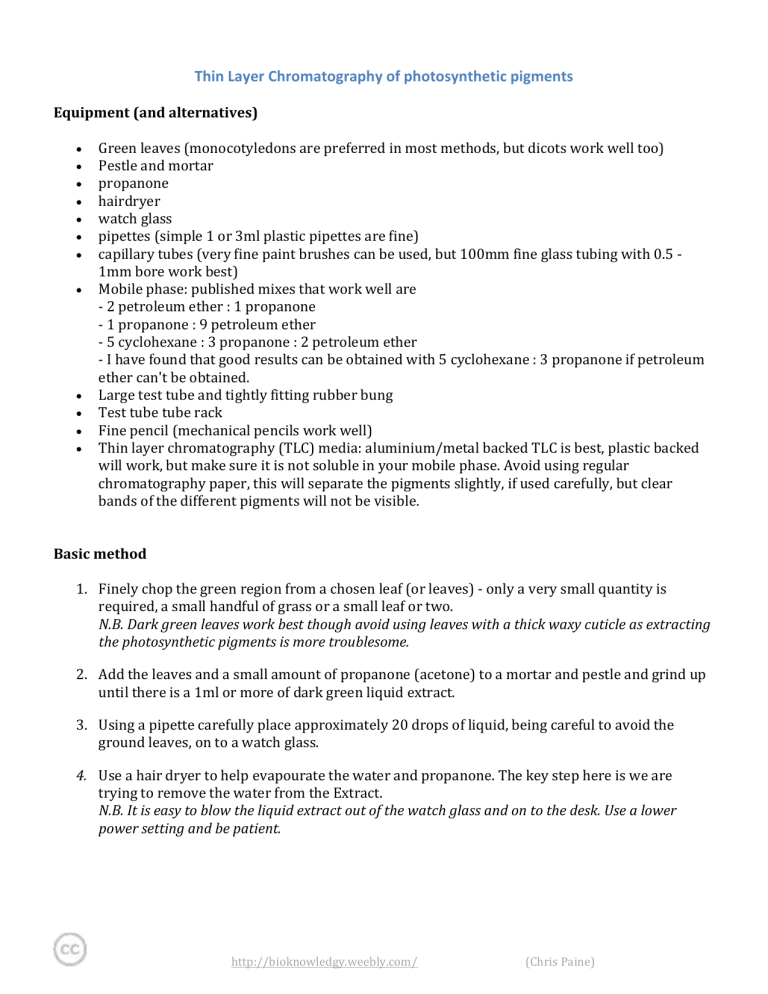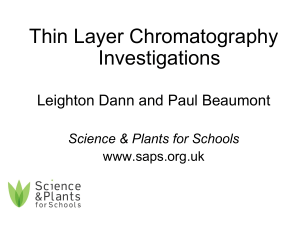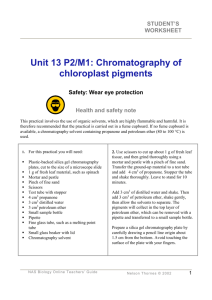
Thin Layer Chromatography of photosynthetic pigments Equipment (and alternatives) Green leaves (monocotyledons are preferred in most methods, but dicots work well too) Pestle and mortar propanone hairdryer watch glass pipettes (simple 1 or 3ml plastic pipettes are fine) capillary tubes (very fine paint brushes can be used, but 100mm fine glass tubing with 0.5 1mm bore work best) Mobile phase: published mixes that work well are - 2 petroleum ether : 1 propanone - 1 propanone : 9 petroleum ether - 5 cyclohexane : 3 propanone : 2 petroleum ether - I have found that good results can be obtained with 5 cyclohexane : 3 propanone if petroleum ether can't be obtained. Large test tube and tightly fitting rubber bung Test tube tube rack Fine pencil (mechanical pencils work well) Thin layer chromatography (TLC) media: aluminium/metal backed TLC is best, plastic backed will work, but make sure it is not soluble in your mobile phase. Avoid using regular chromatography paper, this will separate the pigments slightly, if used carefully, but clear bands of the different pigments will not be visible. Basic method 1. Finely chop the green region from a chosen leaf (or leaves) - only a very small quantity is required, a small handful of grass or a small leaf or two. N.B. Dark green leaves work best though avoid using leaves with a thick waxy cuticle as extracting the photosynthetic pigments is more troublesome. 2. Add the leaves and a small amount of propanone (acetone) to a mortar and pestle and grind up until there is a 1ml or more of dark green liquid extract. 3. Using a pipette carefully place approximately 20 drops of liquid, being careful to avoid the ground leaves, on to a watch glass. 4. Use a hair dryer to help evapourate the water and propanone. The key step here is we are trying to remove the water from the Extract. N.B. It is easy to blow the liquid extract out of the watch glass and on to the desk. Use a lower power setting and be patient. http://bioknowledgy.weebly.com/ (Chris Paine) 5. Cut a strip of TLC media so it is slightly thinner and shorter than your boiling tube. N.B. Avoid touching the side coated with the media. Keep your fingers on the side. 6. Mark a line 20 mm from the bottom of your TLC media. Mark a short vertical line intersecting the middle of the first line. This cross is where you will place the photosynthetic pigments. 7. Add a few drops of propanone to the dried extract. Pickup a small quantity of liquid with a capillary tube and place on the cross mark on the TLC media. Ideally your spot should not be wider than 2-3mm. N.B. When placing the extract if you keep your finger on the top of the capillary tube you can control the amount placed more easily. 8. Wait for the extract to dry and then repeat step 7. 9. Repeat steps 7 and 8 approximately 20 times to make sure you have enough pigment on the media. Your small should be small and very dark. 10. Using a pipette add a depth of 5mm of the mobile phase (solvent) to the boiling tube. Be careful not to get the liquid on the sides of the tube. http://bioknowledgy.weebly.com/ (Chris Paine) 11. Carefully place the prepared TLC media in the boiling tube dot side downwards. The dot should be sitting about 15mm about the solvent. Seal the boiling tube with a rubber bung and place in the rack. 12. Wait until the mobile phase (solvent) has reached almost to the top of the TLC media (this requires 30-45 mins). Then remove the TLC media and mark, with a pencil, the front of the mobile phase. 13. If the chromatography has gone well you should be able to distinguish carotene (orange), breakdown products (grey), chlorophyll a and b (dark and mid green), and xanophyll (yellow). http://bioknowledgy.weebly.com/ (Chris Paine) What next? Possible extensions There are lots of potential extensions to this lab. Some ideas are: Image of a successful chromatogram: Calculate the rf values and compare to published findings Compare the pigments found in different coloured leaves Dissolve the remaining dried extract in ethanol, put it in a cuvette and analyse the action spectrum using a spectrometer Citations: "Investigating Photosynthetic Pigments through TLC." Science and Plants for Schools, n.d. Web. 08 Apr. 2015. <http://www.saps.org.uk/secondary/teaching-resources/189-investigation-of-photosynthetic-pigments-in-greenplants>. http://bioknowledgy.weebly.com/ (Chris Paine)



